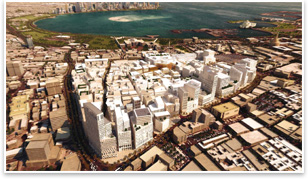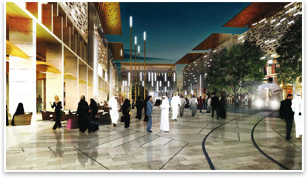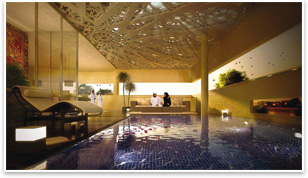
| Heart-of-Doha Design to Regenerate Qatar’s Landscape The sustainable Heart of Doha will connect Doha’s past with its future How do you . . . design an urban plan that transforms a city’s downtown destination? Summary: The Heart of Doha, an urban plan for the historic center of the capital city of Qatar, is designed to transform the district into a network of sustainable interconnecting buildings, public squares, courtyards, and landscaped streets. The design, by Dohaland, a subsidiary of Qatar Foundation, creates a modern city within a city. The urban plan aims to make Doha, the seat of government of Qatar, a destination, combining community, heritage, and tradition. The project is planned for development between 2008 and 2016. The plan is estimated to be 760,000 square meters. The Heart of Doha is targeting LEED™ Gold. 
The Heart of Doha is designed to transform Qatar’s historic district into a network of sustainable interconnecting buildings, public squares, courtyards, and landscaped streets. Modernizing Qatari heritage The project designers hope to reverse Doha’s recent urban sprawl and car congestion while also improving connectivity across the city. The Heart of Doha will even have an entire underground city, thus allowing for pedestrian areas, peaceful squares, and minimal traffic. 
The Heart of Doha is designed to revive Qatar’s heritage and culture and provide a place that allows people to grow and flourish. The Heart of Doha site will be adjacent to the Emiri Diwan, Qatar’s seat of government and ruler’s palace. Development in the Heart of Doha will be based on Dohaland’s five pillars: heritage and culture; innovation, sustainability, enrichment, and environment. The Heart of Doha will use traditional Qatari architecture featuring proportion, simplicity, space, light, layering, ornament, and response to climate. The Heart of Doha honors the traditional architecture of the district. “Qatar has a wonderful architectural history and we are delighted to be able to revive it and share it with the world,” says Eng Issa M. al Mohannadi, Dohaland‘s chief executive officer. “Our ancestors didn’t see the house as just a house—it was a family member. The houses in this area were built by the hearts of the people and the human touch was most important. Family members would use their bare hands to build the home, leaving behind their handprints to illustrate the uniqueness of each house and each family. What is innovative is that it is truly being built for the benefit of people. All decisions are made with two considerations: reviving our heritage and culture and providing a place that allows people to grow and flourish.” 
The Heart of Doha will be based on Dohaland’s five pillars: heritage and culture; innovation, sustainability, enrichment, and environment. The development will be dense, with blocks of interconnecting buildings positioned in clusters, interspersed with a network of squares and courtyards. Landscaped streets will run between major blocks, while smaller access lanes and pedestrian routes will criss-cross. Colonnades will line streets for shading, and there will be a grand central square. The orientation and profiles of the buildings are planned to take advantage of prevailing offshore northerly winds. Human interaction is encouraged. Heart of Doha will be eco-friendly Says al Mohannadi: “Our ancestors did not need state-of-the-art technologies to create buildings that were sustainable and environmentally friendly—they took advantage of what they were given: the wind, the sun, the sand, and the local building materials. The Heart of Doha will utilize the same elements that we have learned from our ancestors, in their modern context.” |
||
Copyright 2009 The American Institute of Architects. All rights reserved. Home Page |
||
home
news headlines
practice
business
design
recent related
› Leeser Wins Helix Hotel Design Competition for Abu Dhabi Development
› New Delhi Office Opens New Market for IA
See what resources are available through the AIA International Program.
The Phaidon Atlas of 21st Century World Architecture, AIA Member price: $156, retail price: $195.

